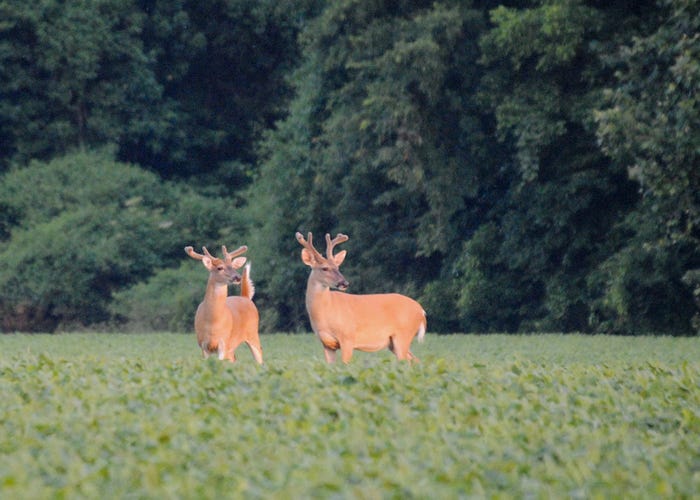
White-tailed deer in soybean field. Wildlife experts estimate Mississippi is home to the densest population of deer in the nation.Mississippi State Extension
Kendall Garraway remembers when a deer sighting was a rare occurrence in Mississippi. He only wishes that were still the case.
“About 15 years ago, the population just blew up, and it’s devastating the damage they can do, seemingly overnight,” Garraway said. “A small field can go from crop to no-crop in the blink of an eye.”
Garraway, along with his uncle and cousin, manage Gaddis Farms, a large family-owned row crop, cattle and timber operation near Bolton, Miss. Like many other farmers in the Magnolia State, Garraway has watched the deer population — and the subsequent damage to his crops — grow exponentially. The population explosion has been a “game changer,” according to Garraway, forcing the family to remove soybeans from the crop rotation in high pressure spots and even abandon farm acres near the Big Black River.
“Some years are worse than others, but we’ve seen total crop losses in some of our smaller fields,” Garraway said. “Even on big fields where we’re harvesting 60 bu/a soybeans in the middle of the field, we’ve seen our yields drop to 5 bu/a on the outer perimeter. That can’t all be attributed to deer, but much of it is directly related to deer feeding.”
Wildlife experts estimate Mississippi is home to the densest population of deer in the nation. Here numbers have expanded from just a few thousand in the 1950s to a current population of nearly 2 million. (To add a little perspective, Mississippi’s human population is just shy of 3 million.)
Of course, deer overpopulation is not just a Mississippi issue. Farms across the nation feel the pressure. With the average adult deer consuming up to seven pounds of food per day, it’s easy to see how the grazing of crops can easily add up to losses of hundreds of millions of dollars for American producers.
Big problem, few solutions
Unfortunately, it’s a problem without a strong solution, although it seems farmers are willing to try anything. In addition to commercial deer repellents, some have tried scattering human hair over their fields, spraying a garlic mixture over crops, or placing dryer sheets or bars of soap around the field perimeter (which, as one farmer put it, only gets you clean and fresh smelling deer).
A quick online search will turn up a plethora of products that supposedly repel deer, but you’d be hard pressed to find a farmer who would endorse them. One Tennessee producer told me he had purchased hot sauce by the gallon and sprayed it on farms with high deer pressure. It worked … until the rain washed the hot sauce away. The farmer determined the practice wasn’t worth the effort. Besides, the hot sauce was clogging the strainer in the sprayer.
Population control can help, but deer soon learn to avoid hunters. And even with depradation permits that allow nighttime harvesting, you can’t be everywhere at once.
“Anytime you have deer and soybeans together, it can be a problem,” said Trent Irby, associate extension professor with Mississippi State University. “The effectiveness of any repellant or control method will be relative to deer pressure. In my observations in high pressure areas, the most consistent method is electric fencing.”
Fencing best bet
Back at Gaddis Farms, Garraway has tried many different deer management tactics, including scare cannons and pepper spray with little success. Besides hunting, the most effective control method he’s found is electric fencing.
“Nothing is as good as an electric fence,” Garraway said. “It’s the only thing that works 24 hours a day.”
Garraway doesn’t fence his entire farm — although he says he knows farmers who have fenced every acre to prevent deer damage. Instead, he selects the “worst places” on the farm for deer pressure. This year he fenced about 25% of his fields. He needs 33 miles of mixed metal polywire to complete the project. His fencing crew begins setting up the fences right after planting, typically completing about two miles of fencing per day.
“The sooner you can get the fence up the better,” Garraway said. “We try to fence right after we plant.”
Another key to success is keeping the fences hot. Since most of his fields are in remote locations without access to power, Garraway uses solar powered energizers to keep the fences charged.
“We keep the fences very hot all the time and don’t turn them off. Our crew is checking them every other day with a digital volt meter. You also have to keep them clean, because they will lose their effectiveness if you let vegetation grow up around the fence. We’ll typically spray herbicide along the fence row at least twice a year.”
Some farmers may only run a fence for three weeks, while others may have to keep the fence up all summer long due to intense deer pressure. Garraway typically leaves his fences up until close to harvest.
Fence design
You’ll hear a lot of different opinions about the optimal fence height and strand count for keeping deer out, and in the past, Garraway has experimented with different fence designs, including a double row electric fence with strands placed at varied heights. But his experiences have shown him that an electric fence doesn’t have to be as tall or as intricate as you might think to be effective.
“The more strands you put up the better, but we’ve found that one strand about knee high, if kept really hot, can be effective,” he said. “It’s preventing about 90% of the deer damage.”
A single strand fence just three feet off the ground doesn’t sound very effective. Deer could easily jump over it to get to the crops they crave. Murray Fulton who oversees the electric fence installation explains that the point of the fence is not to serve as a physical barrier, but as a psychological one.
“Deer, when they’re not frightened, will use their nose to investigate an unfamiliar object. When their nose finds this fence, the deer quickly learn to avoid it,” Fulton said.
Keeping the fence unfamiliar is essential to success. Garraway doesn’t place fencing in the same location year after year. If he rotates a field from soybeans to corn, he’ll move the fencing to a part of the farm where it will be more impactful. The deer don’t have time to get used to it. If the fence can at least deter the deer long enough to give crops time to gain height and mass, they can typically better survive grazing pressure.
Costs
Installing electric fences can involve hefty costs up front. The highly conductive mixed metal polywire strands cost roughly $1,400 per mile. Then there is the cost of multiple energizers, batteries, solar panels and fence posts. Fortunately, all of these products can be re-used, and Garraway has not had to purchase many replacement items over the past four years. The biggest annual costs would be for labor involved in putting up, maintaining and taking down the fences.
In Garraway’s eyes, cost is another reason to go with a single strand fence.
“If a single strand fence will prevent a vast majority of the feeding damage, why invest the extra money and time involved in a multi-strand fence?” he asks.
Even by cutting back to a single strand fence, Garraway admits that the barrier is time consuming to put up and maintain. But he insists it’s worth the added effort to protect yields.
“In some places if you don’t fence you can’t grow a crop.”
Hunting club
In addition to farming, Garraway and his family sell hunting leases and also operate the Halifax Hunting Camp. The abundance of deer and other wildlife have drawn hunters to the property, but Garraway says seasonal hunting has done little to offset deer damage to the farm’s crops.
“It’s very rare to see hunting in the fall and winter have an effect on the deer pressure during the following crop season,” Garraway said. “It just doesn’t have that much of an impact. Depredation permits do help, but fencing is really the most effective deterrent.”
About the Author(s)
You May Also Like






